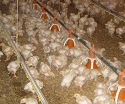 A coalition of environmental organizations on Tuesday will call for Maryland to consider an immediate moratorium on allowing more poultry houses to be built on the Eastern Shore. The groups are responding to a report from the Washington-based Environmental Integrity Project that raises concerns about the number of poultry houses that have been permitted during the past two years. That, in turn, could increase the amount of manure that will need to be transferred to other farms within the Delmarva Peninsula, where large amounts of land are already saturated with phosphorus from chicken litter.
A coalition of environmental organizations on Tuesday will call for Maryland to consider an immediate moratorium on allowing more poultry houses to be built on the Eastern Shore. The groups are responding to a report from the Washington-based Environmental Integrity Project that raises concerns about the number of poultry houses that have been permitted during the past two years. That, in turn, could increase the amount of manure that will need to be transferred to other farms within the Delmarva Peninsula, where large amounts of land are already saturated with phosphorus from chicken litter.
In addition, the report contends that Maryland has stopped long-term water quality monitoring at several sites that were in the middle of chicken country. Without that information, the EIP report said, state officials have no way of knowing whether recent efforts to control pollution from chicken litter are effectively reducing excess manure applications and the amount of phosphorus reaching waterways.
In addition to EIP, those calling for a moratorium include the Maryland Clean Agriculture Coalition, the Johns Hopkins Bloomberg School of Health’s Center for a Livable Future, Food & Water Watch, Waterkeepers Chesapeake, the Midshore Riverkeeper Conservancy, and Assateague Coastkeeper.
They will be making the announcement at noon Monday in a telephone press conference.
The EIP report looked at how many poultry houses were coming online, how large they were and where they were being placed before coming up with its recommendation. Maryland produced 305 million chickens in 2013, with the vast majority of its production coming from its eight Eastern Shore counties where 361 operations generated 215,349 tons of chicken litter containing more than 5 million pounds of phosphorus. About three-quarters of that phosphorus went to other farms on the Shore.
Adding to the problem is the rapid increase in the number of poultry houses that have been permitted this year. Somerset County alone has approved close to 70; Accomack County, VA, has 84 in the pipeline; Kent, DE, is looking at 50. If all those poultry houses come online, the EIP report estimates they will increase chicken production by nearly 27 million birds.
In many cases, local zoning laws are allowing the houses. Farmers are building large chicken houses and often have little, if any, cropland; the property consists only of chicken houses and perhaps a small trailer or home for a manager. As a result, those properties need to transport manure to other farms with suitable soils. Complicating the problem is that soils in large areas of the Eastern Shore have become so saturated with phosphorus that they cannot accept additional chicken litter without increasing phosphorus runoff, which then spurs algae blooms in rivers and the Bay.

Agriculture is the largest source of phosphorus pollution to the Chesapeake, and manure is the largest source of the agricultural phosphorus. But the state eliminated nine of 16 long-term monitoring stations in the area because of cuts from the federal-state Chesapeake Bay Program, according to EIP’s report. Two of those stations are on the Pocomoke River, which was at the heart of the 1997 pfiesteria scare. Scientists later said that poultry manure may have contributed to the water quality problems blamed for the outbreak of pfiesteria, a harmful algae which was alleged to have sickened many fishermen while causing widespread panic about the safety of water contact. The state also cut all of the stations on the Transquaking River, where 92 percent of the phosphorus comes from agriculture runoff.
Gov. Larry Hogan’s administration this year published a rule in the Maryland Register that would phase in regulations by 2024 that would limit the amount of phosphorus farmers could place on their fields. The so-called phosphorus management tool is supposed to help Maryland meet its Chesapeake Bay cleanup goals. But, EIP analyst Courtney Bernhardt argued that the lack of monitoring in key areas means state officials won’t know if the PMT is working.
“They need a strong baseline,” Bernhardt said. “Without it, they’re not going to be able to track progress. They won’t be able to get a complete picture with the stations left behind…they’ve put so much effort into the PMT. To cut its feet off doesn’t make sense.”
The report, “More Phosphorus, Less Monitoring,” can be found on the Environmental Integrity Project’s web site, www.environmentalintegrity.org
